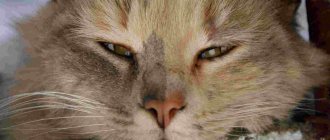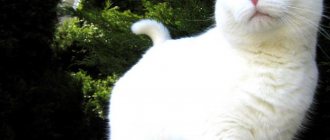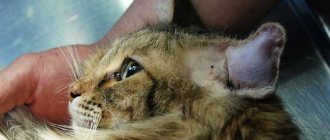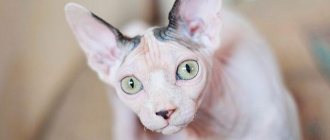The cat is an amazingly beautiful, graceful creature that is very popular among animal lovers. The variety of breeds allows you to choose a purr to suit your taste and color - from a fluffy Persian beauty to a peculiar hairless sphinx with a cosmic look. But some people, fed up with traditional “domestic” cats, prefer their wild counterparts with the unusual color and proud gait of a tiger, lynx or leopard.
We present to you the top 5 most popular wild cats, which often become pets.
Savannah is a hunter with a temperament
This exotic beauty is the result of crossing a domestic purr and a wild serval. The breed owes its appearance to a breeder named Judy Frank, who dreamed of breeding an unusual cat with a wild temperament. She gave rise to breeding work, as a result of which it was possible to obtain a graceful beauty with an amazing spotted color.
Having heard that the Savannah is a hybrid of a wild and domestic cat, many fear that this is an aggressive animal. In fact, this is not true. The exotic purr is affectionate and devoted to one person, and usually shows favor towards other family members. However, this does not mean that the cat will sit in the corner. Savannah is a four-legged hunter who is distinguished by mobility, activity and playfulness.
Where did domestic cats come from?
According to scientists, the main contenders for the role of the ancestors of all cats are the small ancient mammals miacids, which appeared on Earth more than 40 million years ago. These small animals were predators and excellent tree climbers. According to one version, the ancestor of modern pets is the Libyan or steppe cat. This opinion is connected with the habitat of these cats, which was the African continent. It was in Africa, namely in Egypt, that the first cats domesticated by people appeared. The Libyan cat, having sufficient freedom, crossed with other wild relatives. Hence the variety of colors. Other researchers believe that the process of cat domestication occurred simultaneously on almost all continents. And it is this fact that determines the different colors of wool and many breeds.
Lynx (caracal) – a pet for those with character
Most of us are accustomed to thinking of the lynx as a wild animal. However, despite its temperament, this large cat can easily live at home. True, it will not be possible to tame an adult, so the best option is a small kitten, which will become a tame pet thanks to the patience and affection of the owner.
Most often, the caracal is chosen for the home - a spectacular beauty native to Africa with black ears and reddish-brown fur. It has a strong build, long legs and green eyes. By its nature, the caracal can hardly be called a domestic cat, since it is very active, loves solitude and, of course, is a real predator at heart.
It is quite difficult to purchase such an animal, since this type of lynx is sold exclusively in nurseries. There is one more point: caracals value a strong character, so an owner without an inner core will not suit him.
Scientific research
The process of domestication may have begun about 10,000 years ago, when humans settled in the Fertile Crescent, an arched region that includes the eastern shore of the Mediterranean Sea and the land around the Tigris and Euphrates rivers. People stored grain there - the main source of food, which is also loved by rodents, which in turn attracted wild cats. Over time, these wild cats adapted to this artificial environment and got used to people and completely stopped being afraid of them.
Cats were clearly tame around 3,500 years ago in Egypt, where paintings often placed them under chairs. This shows that by that time “the cat had reached the house.” At that time, this animal was a symbol of fertility, since on the frescoes of the ancient Egyptians the cat was depicted under a woman’s chair when the family dreamed of replenishment.
Pixiebob - short-tailed cutie
The cute pixie-bob is somewhat reminiscent of a lynx, and this is not surprising, because breeders sought to get exactly this type of wild cat. True, unlike the lynx, the pixie-bob does not have tassels on its ears. But these animals have an unusually cute face and a very short tail, which can be safely called their distinctive feature. Another interesting nuance: the pixie-bob often has polydactyly (extra number of toes).
When did we become friends?
One would think that archaeological evidence would make it easy to understand when cats were domesticated, but wild cats and domesticated cats have remarkably similar skeletons, complicating research. On the island of Cyprus in 1983, archaeologists discovered the jawbone of a cat that was about 8,000 years old. Since it seemed unlikely that humans would have brought wild cats to the island not yet accustomed to humans, the discovery suggests that domestication occurred even earlier.
In 2004, the discovery of an even more ancient site in Cyprus, in which a cat was deliberately buried with a person, made it even more certain that the island's ancient cats were domesticated earlier, pushing domestication back another 1,500 years.
Housey (Chausie) - an energetic predator
This breed appeared at the end of the last century by crossing an Abyssinian cat with a wild jungle cat. Despite the fact that the Chausie family had far from the most affectionate ancestors, representatives of this breed can be called obedient. They are incredibly smart, active and in excellent health. They can often be seen in motion, are full of energy and love interactive games.
However, a predator is a predator, so the Housie does not get along very well with either children or pets. But a cat of this breed will simply adore the owner, and this is not surprising, because the pet cannot stand loneliness and really appreciates attention!
History of cat domestication
When and where exactly the first cat was tamed by humans is still unknown. One of the assumptions is that the first domestic cats appeared in Ancient Egypt. But this is only one of the versions. In the Indus Valley, archaeologists found the remains of a cat that supposedly lived in 2000 BC. It is almost impossible to determine whether this cat was domestic. The skeletal structure of domestic and wild cats is identical. The only thing that can be said for sure is that the cat was domesticated later than dogs and livestock.
The ancient Egyptians played a huge role in taming cats. They quickly appreciated the important role this agile, graceful animal plays in protecting grain supplies from rats and mice. It is not surprising that in Ancient Egypt the cat was considered a sacred animal. For her deliberate murder, the most severe punishment was due - the death penalty. Accidental murder was punishable by a high fine.
The attitude towards the cat and its importance was reflected in the appearance of the Egyptian gods. The sun god, the main god of the Egyptians, was depicted in the form of a cat. Caring for grain guards was considered an important and honorable task, passed from father to son. The death of a cat became a huge loss; it was mourned by the whole family. A magnificent funeral was held. She was mummified and buried in a specially made sarcophagus, decorated with figurines of cat heads.
The export of cats outside the country was strictly prohibited. A thief caught in the act would face a cruel punishment in the form of the death penalty. But despite all the measures taken, cats got from Egypt to Greece, then to the Roman Empire. The Greeks and Romans have long taken desperate measures to combat rodents that destroy food supplies. Attempts have been made to domesticate ferrets and even snakes for this purpose. The result was disappointing. Cats could be the only means of pest control. As a result, Greek smugglers attempted to steal Egyptian cats at their own peril. Thus, representatives of domestic cats came to Greece and the Roman Empire, spreading throughout Europe.
The first mention of domestic cats in Europe is found in Britain, where they were brought by the Romans. Cats became the only animals that could be kept in monasteries. Their main purpose was still to protect grain reserves from rodents.
In Rus', the first mentions of cats date back to the 14th century. She was valued and revered. The fine for stealing a rodent exterminator was equivalent to the fine for an ox, and that was a lot of money. Attitudes towards cats in Europe changed dramatically to negative in the Middle Ages. A hunt begins for witches and their minions, which are cats, especially black ones. They were credited with supernatural abilities and accused of all sorts of sins. Hunger, illness, and any misfortune were associated with the devil and his personification in the form of a cat. The real hunt for cats has begun. All this horror ended only in the 18th century with the end of the Inquisition. Echoes of hatred towards graceful animals endowed with devilish abilities continued for about another century. Only in the 19th century did superstitions become a thing of the past, and the cat began to be perceived as a pet again. The beginning of a new stage in “cat” history can be considered in 1871, with the holding of the first cat exhibition. The cat receives the status of a pet, remaining so to this day.
Tags: history, cats
Read also (updated 12/03/2020)
Below we have prepared for you links to publications that have recently become particularly popular among our readers:
- how to feed a newborn kitten without a cat;
- why does a cat always want to eat?
- Malamute dog;
- bird robin;
- what a poisonous viper looks like and where it lives.
General information
Representatives of the cat family can be found even in the most remote corners of the planet. The only exceptions are, perhaps, the territory of the Far North and Australia. The smallest of them is considered to be the domestic cat - one of the first animals domesticated by humans.
This predator combines strength, agility, and the ability to lie in wait for prey with a peaceful and affectionate disposition.
Its movements are soft, silent, and its weapons of attack and defense are sharp claws and teeth. Cats have amazing coordination - even falling from a small height, they manage to get back on their feet in time.
The weight of these animals can vary - from 3 to 5 kg, and life expectancy largely depends on conditions and nutrition. In caring hands, a cat can live up to 20 years.
How to train a cat to sharpen its claws?
Surely you have asked yourself the question more than once: How to protect furniture and home interiors from cat claws? In fact, the answer to this question has long been found - direct your pet’s energy to special objects designed for sharpening claws. Buy a scratching post, or better yet, a house or play area, and then your pet will have the opportunity to let loose the beast and have a blast without causing damage to your home. Scratching posts are made from natural materials, such as plant and textile fibers, sisal and bamboo plates. Cats don't care about scratching and tearing, but sisal is the most durable material and will last longer. After you have purchased a scratching post, playground or house, you need to gradually accustom your pet to the new product.
The following tips will tell you how to train your cat to sharpen its claws.
- Choose a suitable place to place the scratching post. It should be available to the cat at any time that is safe for the animal, so that no one disturbs it or takes it by surprise. Take a closer look at your pet, he probably has a favorite place. Place the scratching post there. The ideal option is a corner scratching post.
- Bring your cat to the scratching post and show by personal example that you can sharpen your claws here. As soon as the cat independently repeats after you, praise it and treat it with a treat. Praising your pet and being in a good mood play a very important role in teaching and training animals.
- To speed up the learning process, you can use a special spray to attract cats to the play area. The smell of the spray will instinctively attract the cat, and she will use the scratching post.
Sharpening claws for cats is a natural activity, inherent in nature itself. With the help of these simple tricks we teach our cats to sharpen their claws! Because this process brings pleasure comparable to an outdoor game. You can choose from a variety of scratching posts of interesting shapes and attractive designs to attract the attention of the animal, as well as decorate your home interior. Most scratching posts are equipped with toys, mice, birds and other teasers. Sometimes they come with a bag of dried catnip - cats love this herb! It has an invigorating, cheerful and relaxing effect. The cat will be happy to have a playground with a house where he can have fun, sleep, relax, and, of course, sharpen his claws!
How to accustom a cat to a place, the cat is in a new place.
It is a known fact that animals are more sensitive and receptive than people. Especially when it comes to changes in life. For example, a cat takes much longer to settle in a new place than its owners. She focuses attention on things that people do not notice. For example, smells. If a person moves with a cat to a new place of residence, you need to follow some tips.
How to accustom a cat to a place, you need to be patient. The cat is very restless and unhappy after moving. She can hide, does not allow herself to be petted, does not sit in your arms, and stops going to the cat litter. In rare cases, even nausea and inappropriate behavior occur.
- The cat may be visited by thoughts of returning to its old place of residence.
- It's best to lock her in the house for a few days.
- She will gradually get used to it and begin to forget the old place.
- Before her first walk, it is better to wait until she is hungry, then she will quickly return home to her favorite bowl.
- In the following days, it will be possible to let her out earlier, and thus gradually increase the interval between walking and feeding.
To alleviate her condition, you should install a cat corner. The cat's things should be placed in the places where they will remain in the future. Also display those items that are familiar to the cat. It is better not to install new items and furniture for a while. You can also lay out your clothes around the house, the cat will smell a familiar smell.
According to signs, the cat is the first to enter a new house, but if it is your cat, it is better not to do this. Quite the contrary, when moving a cat should be left with well-known and close people whom the animal knows. The sight of packed items can shock your cat and cause stress. After moving, you should arrange the animal's things and organize her house. After this, the cat can be brought to a new home.
If this is not an apartment, but a private house, it is better not to let the cat outside for a while. Even so that she does not run away from fear. First he should get comfortable inside the house. The rooms in the house also need to be opened one at a time so that familiarization proceeds gradually.
It will take a lot of time for a cat to adapt to a new home, sometimes it takes several weeks. After completely mastering the house, the cat will finally stop rubbing against the furniture and marking its territory.
The article tells how to accustom a cat to its new habitat. After a while, the cat will get used to the new place and return to its normal lifestyle.
In this case, it is best for people to show patience and surround the animal with affection and care.











